Stone, minerals and semiprecious of the world stone
Carbonate: Azurite -->rus
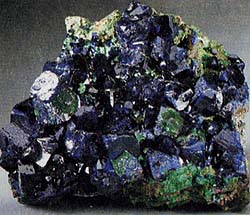 Diagnostic cart.
Diagnostic cart.
On a photo: shortly-prismatic crystals, partly deputized malachite (Arizona). Down: radiant aggregates of Azurite with olivine.
Cu3 (СO3)2 (OH)2
Crystal structure monoclinic
Hardness on the Mohs scale 3,5-4
Specific unit weight mass 3,7-3,9
Cleavage shows up easily
Fracture, break padman
Colors intensively-dark blue
Colors in powder triturate dark blue
Glance (glitter, glare) from glass to diamond

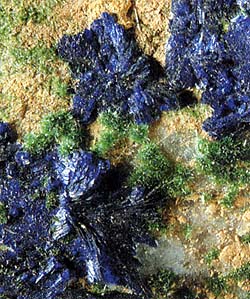 Azurite is crystallized in monoclinic Crystal structure. His crystals are the extended prisms or tablets, with shading, rich in verges. Separate individuals are enough rare, much more frequent - accrete or incorporated in the aggregates of radiant structure crystals. There is goodcleavage. Often they are covered an earthy raid, pseudomorphosis of Azurite is enough widespread on other minerals.
Azurite is crystallized in monoclinic Crystal structure. His crystals are the extended prisms or tablets, with shading, rich in verges. Separate individuals are enough rare, much more frequent - accrete or incorporated in the aggregates of radiant structure crystals. There is goodcleavage. Often they are covered an earthy raid, pseudomorphosis of Azurite is enough widespread on other minerals.
An azure-blue mineral associated with copper deposits. It is a source of copper. Composition: copper carbonate. Formula: Cu3(CO3)2(OH)2. Crystal structure: monoclinic Colors intensively-dark blue, brilliance of glassy, sometimes near to to diamond. Azurite transparent, sometimes transparent; an in powder triturate color is always dark blue. Heavy, to middle hardness: scratches a knife-blade.
Chemical composition (chemistry, compound). Oxide of copper (Suo) 69,2% (Su, 55,3%), dioxide of carbon (CO2) 25,6%, water (H2O) 5,2%. Form of crystals. Often there are beautiful many-sided crystals, formative shallow Druses; short, long-prismatic, thickplate tablet lamellar crystals. Class of symmetry. Prismatic - 2/m. Aggregates,. Dense grainy the masses, radially-radiant aggregates, earthy accumulations.
Diagnostic indication.
Taking into account all of descriptions of Azurite, him it is practically impossible to entangle with other minerals. As well as almost all of carbonates, it with boiling up dissolves in acids, including dilute; paints flame in a green color, that characteristically for compounds of copper. Azurite easily changes and passes to malachite. Fuse melt, the kinglet of copper gives in restoration flame. A behavior is in acids. Dissolves in muriatic acid (with hissing).
Origin provenance genesis.
Azurite is the second mineral, appearing at transformation of sulfides of copper in the conditions of enriching, surrounding rocks carbonate solutions. Associated with malachite which, substituting for him, often forms pseudomorphosis on him. Azurite sometimes can appear due to saturating with of siltages (mainly sandstones) carbonate waters, by the enriched sulfates of copper. Besides malachite Azurite can be associated with other minerals of copper, and also with swamp ore and Calcite.
Deposit minefield mine field occurrence subsoil.
Beautiful crystals are known from Shessi (Lyon, France), from Cumeb (Namibia), from Lavrion (Greece) and many mineries of the state Arizona (USA). Found out notable crystals, often deputized malachite (pseudomorphosis), in Broken-khill in Australia. Found out Azurite on all of deposits of copper in the desert of Atakama in Chile.
Use, practical application, deployment.
Azurite due to the color and brilliance finds a wideuse as carpentry stone for making of shallow decorations. If to process him fasings, it is possible to get beautiful jeweller wares; but as it is fragile and easily disintelattices on cleavage, better than him in this quality not to use. In the past Azurite ground millstones and used as a pigment at making of paints for painting. Artists valued him highly; however much colors on pictures appeared unsteady: Azurite, taking in moisture from air, passed to malachite and color became green (sky greened, sea et cetera).
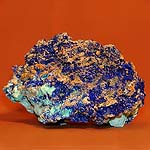
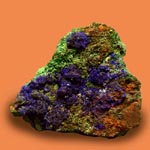
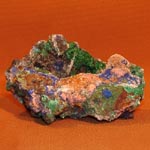
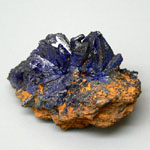

Got the name Azurite on a light-blue-dark blue color, and synonym - on composition. Glance (glitter, glare) for him glassy. Be found together with malachite in the area of oxidization of deposits of copper or in a direct closeness from them. The aggregates of shallow spherulites are characteristic. Widespread on the copper deposits of Australia, Chile, Mexico, CIS (Ural, Ore Altai), USA (state Arizona, Pennsylvania) and France, EU (near Lyon).
The best jeweller-carpentry Azurite obtain in Zaire. Before this mineral was used for preparation dark blue paints. Insignificant hardness allows to apply Azurite only in rock-cutting industry, but collectors polish from him also cabochons and cut even. Entangling Azurite is possible with many dark blue minerals, it is especially alike on Dumorterite, hauyne, Lazurite, Lapis lazuli, lazulite, Sodalite. Sometimes Azurite and malachite accrete in single, outwardly very showy aggregate: azure-malachite. Azure is dark blue aniline ink, got from azurita and applied in laboratory practice for colouring of preparations.
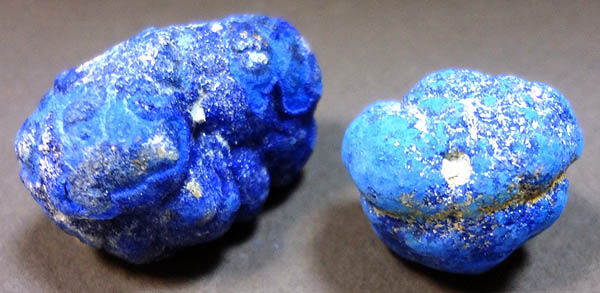
Azurite. Mikheevskoe mine, 20 km to Varna, Ural, Russia, CIS. ~3 sm. A photo: © A.A. Evseev.
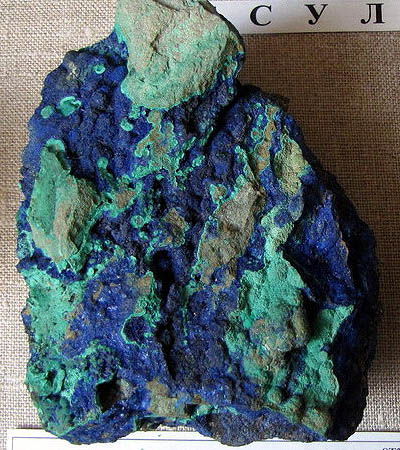
Azurite with malachite. Uchaly, Ural, Russia, CIS. A photo: © A.A. Evseev.
